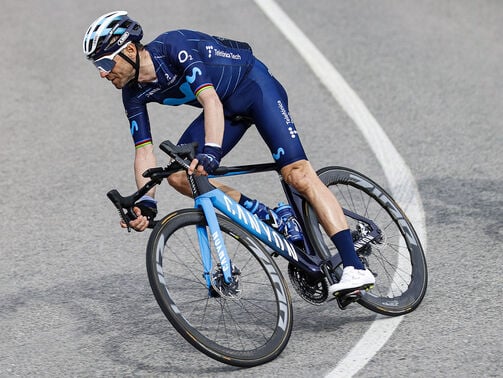Cyclocross bikes vs road bikes: Which one is right for you?
Take a closer look at cyclocross vs road bikes and the nuances in design that make each better suited for their intended purpose.


Cyclocross bikes vs road bikes—what’s the big difference? These machines are purpose-built for different adventures: one thrives in rugged, mixed terrain, and the other excels on smooth, fast roads.
Road bikes cover numerous of designs and capabilities, from racing to endurance styles. Cyclocross (CX) bikes cover an even broader range. While there's plenty of crossover between categories, knowing what a bike is best at and picking the right model for the job can greatly improve your riding experience.
Let’s take a closer look at a CX vs road bike.
Contents
Geometry and frame differences
Whether you're flat-out road racing or ripping around a cyclocross course, ‘cross bikes and road bikes are designed with subtle geometry and frame tweaks that make all the difference.
- Road bikes: Fast riding on smooth surfaces
Road bikes are specifically designed for paved roads, featuring a geometry optimised for stability, speed, and longer rides. With a shorter wheelbase and aerodynamic features like streamlined frame shapes and narrower tubing, they offer quicker handling and reduced air resistance—ideal for racing and training on smooth surfaces.
Read more about a road bike’s geometry.
- Cross Bikes: Obstacle-ready race machines
The purpose-built design of a cyclocross bike is to handle the demanding and varied terrain encountered in cyclocross racing. This includes riding over mud, dirt, grass, sand, and navigating obstacles like barriers and steep hills.
‘Cross bikes are designed for agility and explosiveness, with a slightly taller stack and shorter reach for better off-road handling. Their higher bottom bracket provides essential clearance over obstacles in rough terrain.
While ‘cross bikes are slightly heavier and less aerodynamic than road bikes, they excel as all-terrain machines, offering more versatility and ease (albeit with a trade-off in speed and stability on smooth surfaces).
Tyres and tyre clearance distinctions
When it comes to tyres, road bikes and cyclocross bikes are each tailored for their specific playground.
Road bikes sport narrow, slick tyres—typically 25c to 28c—designed to maximise acceleration and speed on smooth asphalt.
Cyclocross bikes are equipped with wider tyres, usually between 30c and 40c. UCI (the governing body for international competitive cycling) race regulations cap tyre width at 33c. These tyres feature varying tread patterns to handle dirt, grass, and mud with ease.
A key difference between the bikes lies in the larger tyre clearance found on cyclocross bikes. This clearance not only accommodates bigger tyres but also allows for the installation of fenders—useful when tackling the muddy, rainy cyclocross season.

Cyclocross vs road bike performance comparison: Aerodynamics and speed
The cyclocross bike is going to be slightly heavier than the road bike and, on-tarmac, trail tyres will have greater rolling resistance than a smooth, narrow road tyre at high pressure.
On paved roads, a road bike will feel faster, more responsive, and more efficient. The rider may also notice that a CX bike feels slower or more sluggish on smooth terrain due to its wider tyres, more upright geometry, and higher weight.
For casual riders or those not focused on performance, these differences might be less noticeable, but for those pushing the limits, the speed difference can be as much as 10 kph on the road, depending on the model.
Comfort and riding experience on different surfaces
Stiff and efficient, road bikes are built for speed on smooth, paved roads. Endurance-oriented models can handle rougher surfaces and even cobblestones, but riding over bumps and potholes could risk damaging a road bike's rims (not to mention being uncomfortable).
While perfect for cyclocross racing, cyclocross bikes also excel as versatile all-rounders. Their design is tailored for technical handling on mixed surfaces like dirt, mud, sand, and grass. With a few simple modifications, they can transition into all-road or gravel bikes, making them adaptable to various terrains.

Gear Compatibility: Components and accessories for each bike
Both road bikes and cyclocross (CX) bikes are equipped with streamlined components and minimal gear, each carefully selected to optimise performance for their specific riding demands.
- Drivetrain and Gearing
Cyclocross bikes typically have a narrower gear range, often with 46-36 chainrings and 11-28 cassettes, suited for varied terrain and the demands of cyclocross racing.
Road bikes usually feature 50-34 chainrings with 11-28 or 11-32 cassettes, offering higher gear ratios and close spacing optimised for smooth, fast pedalling on paved surfaces.
- Brakes
Cyclocross bikes almost exclusively use disc brakes, essential for maintaining control and effective braking in the muddy, wet, and rough conditions common in cyclocross racing. Disc brakes are also becoming more popular on road bikes due to their superior stopping power, ideal for high-speed road cycling.
- Accessories
Cyclocross bike accessories are geared toward durability and functionality in harsh conditions. Items like mudguards or frame protectors help handle the demands of off-road racing.
Most road bikes are kept minimal, especially for shorter rides or competitive events, where reducing weight and maximising aerodynamics are crucial.
Maintenance and durability: Long-term considerations
The maintenance and durability of cyclocross vs road bikes take on a whole new meaning when racing is synonymous with mud, grit, and rough terrain.
- Maintenance
Cyclocross (CX) bikes endure winter’s worst, regularly tackling rough courses filled with mud and obstacles. This rugged environment makes regular cleaning and lubrication crucial to prevent rust and keep the bike performing at its best. Road bikes need regular care but typically face less demanding conditions.
- Durability
CX bikes are built to withstand rougher terrain and harsher environments. They feature more robust frames, wheels, and components designed to handle impacts and debris from ripping around a cross course. This durability makes them slightly heavier but better suited for off-road challenges.
Whatever the bike, regular care and upkeep can significantly extend the lifespan of both CX and road bikes.

Conclusion: Choosing the right bike for your needs
A cyclocross bike is primarily designed for the demands of cyclocross racing, but its versatile frame makes it a great all-rounder. Riders often use CX bikes for commuting, training, road races, and, of course, ‘cross racing.
While a good cyclocross bike can double as a road bike with a simple tyre swap, the reverse isn't true. A road bike's geometry isn’t typically suited for the rigours of off-road riding, making it less effective if you try to turn it into a CX bike with wider tyres.
If you're more interested in recreational mixed-terrain riding than competitive cyclocross, consider a gravel bike. Gravel bikes share similarities with CX bikes but offer more creature comforts and a more relaxed riding style. With a lower bottom bracket and slacker angles, gravel bikes provide increased off-road stability and a more upright position for long-distance comfort.
On the other hand, if speed and aerodynamics on paved roads are your main goals, especially for road racing, then a dedicated road bike is the better choice. Professional teams like Movistar, Alpecin-Deceuninck, and CANYON//SRAM Racing use a fleet of Canyon road bikes.
Take a look at the full range of Canyon’s bikes and find the right model for your needs.
Discover our Gravel Bikes
Did this article help?
Thank you for your feedback
-
 About the author
About the authorKimberly Hobson
Get to know Kim Hobson, a digital marketer and copywriter with a passion for the outdoors and all things on wheels.








